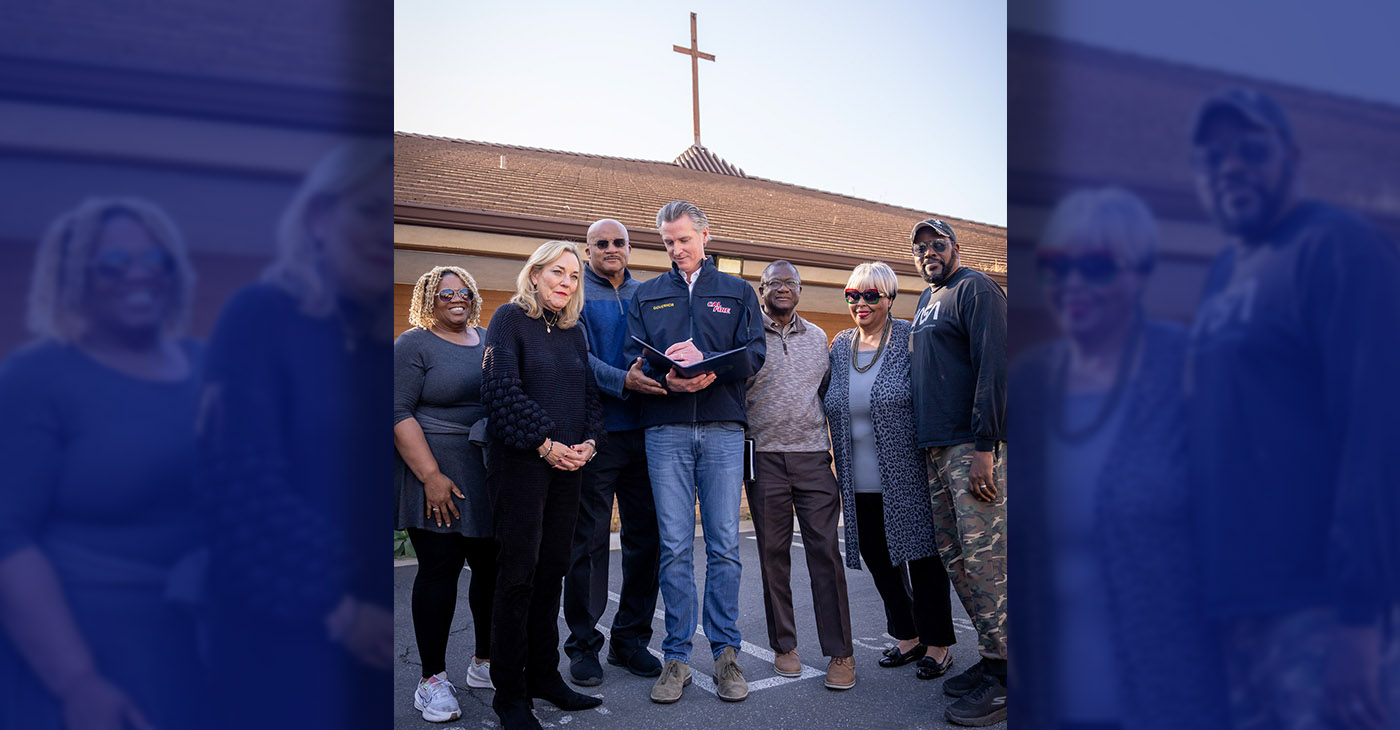Activism
California Reparations Task Force Looks at Long History of Racism in American Agriculture
In March, the U.S. Congress passed a $4 billion debt relief program for farmers of color to address past discrimination in USDA programs. The debt relief program was passed as part of the ARP. It includes funding to pay off USDA loans held by 16,000 Black, Native American, Alaskan Native, Asian American, Pacific Islander, and Hispanic and Latino farmers.

By Antonio Ray Harvey | California Black Media
Last month, Lawrence Lucas, founder of the United States Department of Agriculture Coalition of Minority Employees (USDA-CME), testified before the California Task Force to Study and Develop Reparation Proposals for African Americans.
Lucas said racism is the prime reason there are just a little over 400 Black farmers in California.
“The income of Black Farmers has been drastically reduced and the amount of wealth that has been taken from Black farmers is tremendous,” Lucas said. “What you would call reparations, we call justice. It is why you must do what you have to do in California to right the wrongs suffered by Black people.”
Lucas is not the only one concerned about mounting evidence that documents a long history of race-based discrimination in American agriculture.
The United States Department of Agriculture recently created the Equity Commission (EC) to study racial discrimination and government policies that have disempowered Black farmers, depleted their wealth and nearly wiped out their presence for over 100 years.
EC will advise the Secretary of Agriculture by identifying USDA programs, policies, systems, structures, and practices that created barriers to inclusion or perpetuated racial, economic, health and social disparities.
USDA-CME was founded in 1994 to address discrimination within the USDA, which Lucas referred to as the “Last Plantation” during his testimony. The coalition also focuses its work on the historical loss of Black-owned land and how government policies deprived African Americans of generational wealth.
The EC is expected to issue a preliminary report and provide “actionable recommendations” within the next 12 months, and a final report to be finished within two years.
“The Equity Commission is taking important steps to dismantle barriers historically underserved communities have faced in accessing USDA programs and services,” said U.S. Agriculture Secretary Tom Vilsack in a statement issued on September 24.
Lucas said despite the USDA’s efforts to address decades-old discrimination practices, he does not see it “getting any better” for Black farmers. Non-Black farm producers are fighting back in the courts, Lucas said.
“You have white farmers, who own most of the land and get all the benefits from the land; they are the ones now bringing court cases around the country. They are saying that it’s discriminatory to have debt-relief for Black farmers,” Lucas said.
The CME’s biggest accomplishment is its involvement in securing debt relief for Black farmers as part of the American Rescue Plan (ARP). The ARP package included a multi-billion-dollar fund for socially disadvantaged farmers throughout the United States.
The coalition has worked alongside U.S. Senators Elizabeth Warren (D-MA) and Cory Booker (D-NJ) to create the Justice for Black Farmers Act, which will provide even more aid to socially disadvantaged farmers.
Of the approximately 70,000 farms in California, more than 90% are white-owned or white-managed and fewer than 1% are Black-owned or Black-managed, according to the 2017 federal agriculture census.
The 2012 census reported that California had 722 Black farmers. By 2017, that number had decreased to 429. Nationally, there are 45,508 Black farmers or 1.3% of all farmers according to the 2017 agriculture census. Their properties account for 0.5% of the country’s farmlands.
In contrast, about 14% of all U.S. farmers in 1920 were Black, according to that year’s agriculture census. At the time, there were 925,708 Black farmers. Nearly all of them farmed in Deep South states. Lucas blames the USDA for the depletion of Black farmlands over the last century.
However, the USDA says it is in the process of reversing harmful policies and taking restorative action for programs that affected the progress, financial stability, and productive livelihood of Black farmers.
“We are serious about our efforts to end discrimination across all areas of the Department and to improve access to services for key stakeholders,” said USDA Deputy Secretary Jewel Bronaugh in a statement.
In March, the U.S. Congress passed a $4 billion debt relief program for farmers of color to address past discrimination in USDA programs.
The debt relief program was passed as part of the ARP. It includes funding to pay off USDA loans held by 16,000 Black, Native American, Alaskan Native, Asian American, Pacific Islander, and Hispanic and Latino farmers.
Claiming discrimination, a group of white farmers have filed a dozen lawsuits against the program including one class action suit. Preliminary injunctions by three courts have momentarily blocked the program from issuing funds from the program.
According to Khubaka Michael Harris of the California Black Farmers and Agriculturalists Association (CBFAA), “The debt relief was written in a way to help Black folks, but it is not just for Black folks. That’s why it’s in the courts. It was written where anybody who is a farmer can say, ‘Hey, I’ve been affected by COVID, too.’ Then, you are going to say that this money is just earmarked for Black folks? Now, the legislators have to go back to write in a language that targets underserved communities.”
Based in Sacramento, CBFAA advocates for socially disadvantaged California Black farmers, and agriculturalists of color nationwide.
Lucas said it is actions such as the lawsuits that “deny Black farmers their dignity,” “a right to farm,” and deny Black farmers the “right to the same programs and services that white farmers get in this country.”
In California, farming is classified under the term “agricultural activity.”
The state defines it as “the harvesting of any agricultural commodity, including timber, viticulture, apiculture, or horticulture, the raising of livestock, fur-bearing animals, fish, or poultry, and any practices performed by a farmer or on a farm are also agricultural activities.”
“That goes for licensed cannabis farmers, too,” Harris said. “If you cultivate cannabis you are a farmer in this state.”
Assembly Bill (AB) 3121, titled “The Task Force to Study and Develop Reparation Proposals for African Americans,” was a law created to investigate the history of slavery in the United States, the extent of California’s involvement in slavery, segregation, and the denial of Black citizens their constitutional rights.
The nine-member task force is expected to hear more testimonies from Black farmers in California, including producers from the Central Valley.
“I see what all of you in California are doing is what needs to be done across this country,” Lucas said during his testimony. “It is the courage of your governor and the courage of the people on this Reparation Committee to take on this daunting task of talking to other people about their pain and suffering. Black farmers are suffering.”
Activism
Gov. Newsom Approves $170 Million to Fast Track Wildfire Resilience
AB 100 approves major investments in regional conservancies across the state, including over $30 million each for the Sierra Nevada, Santa Monica Mountains, State Coastal, and San Gabriel/Lower LA Rivers and Mountains conservancies. An additional $10 million will support wildfire response and resilience efforts.

By Bo Tefu
California Black Media
With wildfire season approaching, last week Gov. Gavin Newsom signed Assembly Bill (AB) 100, unlocking $170 million to fast-track wildfire prevention and forest management projects — many of which directly protect communities of color, who are often hardest hit by climate-driven disasters.
“With this latest round of funding, we’re continuing to increase the speed and size of forest and vegetation management essential to protecting communities,” said Newsom when he announced the funding on April 14.
“We are leaving no stone unturned — including cutting red tape — in our mission to ensure our neighborhoods are protected from destructive wildfires,” he said.
AB 100 approves major investments in regional conservancies across the state, including over $30 million each for the Sierra Nevada, Santa Monica Mountains, State Coastal, and San Gabriel/Lower LA Rivers and Mountains conservancies. An additional $10 million will support wildfire response and resilience efforts.
Newsom also signed an executive order suspending certain regulations to allow urgent work to move forward faster.
This funding builds on California’s broader Wildfire and Forest Resilience Action Plan, a $2.7 billion effort to reduce fuel loads, increase prescribed burning, and harden communities. The state has also launched new dashboards to keep the public informed and hold agencies accountable.
California has also committed to continue investing $200 million annually through 2028 to expand this effort, ensuring long-term resilience, particularly in vulnerable communities.
Activism
California Rideshare Drivers and Supporters Step Up Push to Unionize
Today in California, over 600,000 rideshare drivers want the ability to form or join unions for the sole purpose of collective bargaining or other mutual aid and protection. It’s a right, and recently at the State Capitol, a large number of people, including some rideshare drivers and others working in the gig economy, reaffirmed that they want to exercise it.

By Antonio Ray Harvey
California Black Media
On July 5, 1935, President Franklin D. Roosevelt signed into federal law the National Labor Relations Act (NLRA). Also known as the “Wagner Act,” the law paved the way for employees to have “the right to self-organization, to form, join, or assist labor organizations,” and “to bargain collectively through representatives of their own choosing, according to the legislation’s language.
Today in California, over 600,000 rideshare drivers want the ability to form or join unions for the sole purpose of collective bargaining or other mutual aid and protection. It’s a right, and recently at the State Capitol, a large number of people, including some rideshare drivers and others working in the gig economy, reaffirmed that they want to exercise it.
On April 8, the rideshare drivers held a rally with lawmakers to garner support for Assembly Bill (AB) 1340, the “Transportation Network Company Drivers (TNC) Labor Relations Act.”
Authored by Assemblymembers Buffy Wicks (D-Oakland) and Marc Berman (D-Menlo Park), AB 1340 would allow drivers to create a union and negotiate contracts with industry leaders like Uber and Lyft.
“All work has dignity, and every worker deserves a voice — especially in these uncertain times,” Wicks said at the rally. “AB 1340 empowers drivers with the choice to join a union and negotiate for better wages, benefits, and protections. When workers stand together, they are one of the most powerful forces for justice in California.”
Wicks and Berman were joined by three members of the California Legislative Black Caucus (CLBC): Assemblymembers Tina McKinnor (D-Inglewood), Sade Elhawary (D-Los Angeles), and Isaac Bryan (D-Ladera Heights).
Yvonne Wheeler, president of the Los Angeles County Federation of Labor; April Verrett, President of Service Employees International Union (SEIU); Tia Orr, Executive Director of SEIU; and a host of others participated in the demonstration on the grounds of the state capitol.
“This is not a gig. This is your life. This is your job,” Bryan said at the rally. “When we organize and fight for our collective needs, it pulls from the people who have so much that they don’t know what to do with it and puts it in the hands of people who are struggling every single day.”
Existing law, the “Protect App-Based Drivers and Services Act,” created by Proposition (Prop) 22, a ballot initiative, categorizes app-based drivers for companies such as Uber and Lyft as independent contractors.
Prop 22 was approved by voters in the November 2020 statewide general election. Since then, Prop 22 has been in court facing challenges from groups trying to overturn it.
However, last July, Prop 22 was upheld by the California Supreme Court last July.
In a 2024, statement after the ruling, Lyft stated that 80% of the rideshare drivers they surveyed acknowledged that Prop 22 “was good for them” and “median hourly earnings of drivers on the Lyft platform in California were 22% higher in 2023 than in 2019.”
Wicks and Berman crafted AB 1340 to circumvent Prop 22.
“With AB 1340, we are putting power in the hands of hundreds of thousands of workers to raise the bar in their industry and create a model for an equitable and innovative partnership in the tech sector,” Berman said.
Activism
California Holds the Line on DEI as Trump Administration Threatens School Funding
The conflict began on Feb. 14, when Craig Trainor, acting assistant secretary for civil rights at the U.S. Department of Education (DOE), issued a “Dear Colleague” letter warning that DEI-related programs in public schools could violate federal civil rights law. The letter, which cited Title VI of the Civil Rights Act and the 2023 Supreme Court ruling in Students for Fair Admissions v. Harvard, which ended race-conscious admissions, ordered schools to eliminate race-based considerations in areas such as admissions, scholarships, hiring, discipline, and student programming.

By Joe W. Bowers Jr
California Black Media
California education leaders are pushing back against the Trump administration’s directive to dismantle diversity, equity, and inclusion (DEI) programs in its K-12 public schools — despite threats to take away billions in federal funding.
The conflict began on Feb. 14, when Craig Trainor, acting assistant secretary for civil rights at the U.S. Department of Education (DOE), issued a “Dear Colleague” letter warning that DEI-related programs in public schools could violate federal civil rights law. The letter, which cited Title VI of the Civil Rights Act and the 2023 Supreme Court ruling in Students for Fair Admissions v. Harvard, which ended race-conscious admissions, ordered schools to eliminate race-based considerations in areas such as admissions, scholarships, hiring, discipline, and student programming.
According to Trainor, “DEI programs discriminate against one group of Americans to favor another.”
On April 3, the DOE escalated the pressure, sending a follow-up letter to states demanding that every local educational agency (LEA) certify — within 10 business days — that they were not using federal funds to support “illegal DEI.” The certification requirement, tied to continued federal aid, raised the stakes for California, which receives more than $16 billion annually in federal education funding.
So far, California has refused to comply with the DOE order.
“There is nothing in state or federal law that outlaws the broad concepts of ‘diversity,’ ‘equity,’ or ‘inclusion,’” wrote David Schapira, California’s Chief Deputy Superintendent of Public Instruction, in an April 4 letter to superintendents and charter school administrators. Schapira noted that all of California’s more than 1,000 traditional public school districts submit Title VI compliance assurances annually and are subject to regular oversight by the state and the federal government.
In a formal response to the DOE on April 11, the California Department of Education, the State Board of Education, and State Superintendent of Public Instruction Tony Thurmond collectively rejected the certification demand, calling it vague, legally unsupported, and procedurally improper.
“California and its nearly 2,000 LEAs (including traditional public schools and charter schools) have already provided the requisite guarantee that its programs and services are, and will be, in compliance with Title VI and its implementing regulation,” the letter says.
Thurmond added in a statement, “Today, California affirmed existing and continued compliance with federal laws while we stay the course to move the needle for all students. As our responses to the United States Department of Education state and as the plain text of state and federal laws affirm, there is nothing unlawful about broad core values such as diversity, equity and inclusion. I am proud of our students, educators and school communities who continue to focus on teaching and learning, despite federal actions intended to distract and disrupt.”
California officials say that the federal government cannot change existing civil rights enforcement standards without going through formal rule-making procedures, which require public notice and comment.
Other states are taking a similar approach. In a letter to the DOE, Daniel Morton-Bentley, deputy commissioner and counsel for the New York State Education Department, wrote, “We understand that the current administration seeks to censor anything it deems ‘diversity, equity & inclusion.’ But there are no federal or State laws prohibiting the principles of DEI.”
-

 Activism4 weeks ago
Activism4 weeks agoOakland Post Endorses Barbara Lee
-

 Activism3 weeks ago
Activism3 weeks agoOakland Post: Week of April 2 – 8, 2025
-

 #NNPA BlackPress3 weeks ago
#NNPA BlackPress3 weeks agoTrump Profits, Black America Pays the Price
-

 Activism2 weeks ago
Activism2 weeks agoOakland Post: Week of April 9 – 15, 2025
-

 #NNPA BlackPress3 weeks ago
#NNPA BlackPress3 weeks agoHarriet Tubman Scrubbed; DEI Dismantled
-

 #NNPA BlackPress3 weeks ago
#NNPA BlackPress3 weeks agoTrump Targets a Slavery Removal from the National Museum of African-American History and Culture
-

 #NNPA BlackPress3 weeks ago
#NNPA BlackPress3 weeks agoLawmakers Greenlight Reparations Study for Descendants of Enslaved Marylanders
-

 #NNPA BlackPress3 weeks ago
#NNPA BlackPress3 weeks agoNew York Stands Firm Against Trump Administration’s Order to Abandon Diversity in Schools





















































